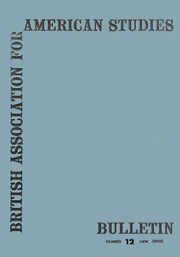No CrossRef data available.
Article contents
Joel Barlow's The Hasty Pudding: A Study in American Neoclassicism
Published online by Cambridge University Press: 17 February 2011
Extract
Although he was known by his contemporaries as a political figure and as the author of a long “philosophical” poem entitled The Vision of Columbus (1787), later retitled The Columbiad (1807), Joel Barlow's name and fame, such as they are today, have survived solely by his humorous poem The Hasty Pudding (1796). While it is not the purpose of this paper to provide a critical estimate of the poem, the judgment of posterity appears just; for The Hasty Pudding remains readable, whereas Columbus seems an interminable muddle. It is commonly remarked that the neoclassical literature of England particularly influenced that of eighteenth century America; but specific studies of this influence are not so common. To study selected elements demonstrating this influence in The Hasty Pudding is the aim of this paper. These elements are respectively form, poetic genres, borrowings, and tone.
- Type
- Research Article
- Information
- Copyright
- Copyright © British Association for American Studies 1965




